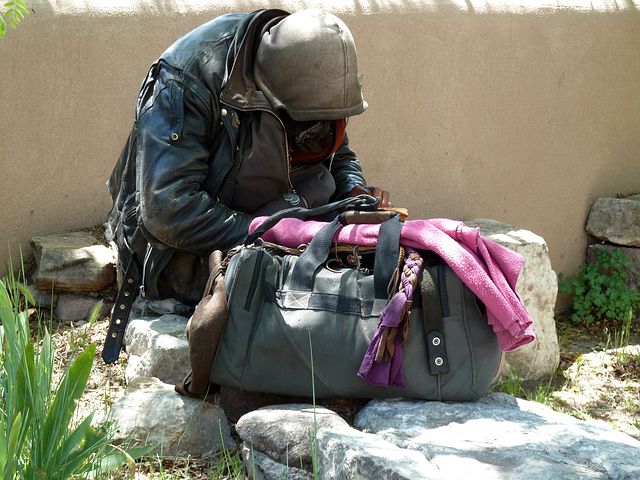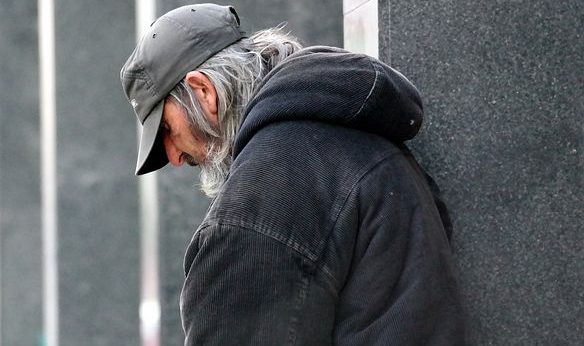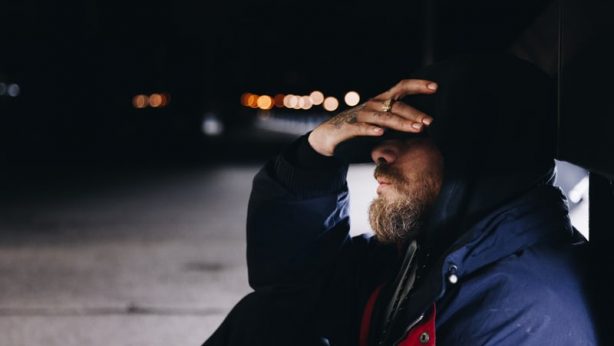Safe places to sleep elude county’s homeless, who spend nights with ‘one eye open’

Feb 4, 2020
The county has no walk-in shelters. Some say they’re ineffective in getting people out of homelessness. Those left to sleep outdoors say it exposes them to crime and bad weather.
WEST PALM BEACH — Lindsey Parker said he never had a home while he spent 12 years traveling across the United States to work at carnivals. Now he is homeless in West Palm Beach and looking for work.
Parker described himself as a mechanical technician who constructs, operates and tears down carnival rides. He said the past several years have been painful. He talked about his wife’s death 13 years ago. He said he’s learned he has colon cancer and has lost quite a bit of weight. Yet he still takes pride in making people happy.
“At one point in time, your child or you have gotten on one of my rides,” Parker said recently from St. Ann Place, a daytime resource center for the homeless in West Palm Beach. “I was the one who made you smile.”
Parker is looking for things that make him smile. One would be a safe, indoor place to sleep at night, one removed from the thefts and sexual assaults he and others say the homeless in Palm Beach County can experience. Palm Beach County has no walk-in shelters, and the few places where beds might be available require a placement, or a waiting list.
James Green, Palm Beach County community service director says the U.S. Department of Housing and Urban Development does not support walk-in shelters in Palm Beach County, saying they “haven’t been proven effective” in helping people “transition out of homelessness.” Shelters offering 60- or 90-day stays have proven more successful, he said.
Michael Williams, the administrative director of the Senator Philip D. Lewis Center near 45th Street and Mangonia Drive, says centers often have requirements. At the Lewis Center, named for the late state Senate president who championed the rights of the homeless, clients must be a Palm Beach County resident for at least six months, which Parker is not.
Other agencies, such as Adopt-A-Family, only accept families with children.
Through the Palm Beach County Homeless Outreach Team, authorities strive to provide people like Parker with resources, but sometimes all they can offer is a blanket. And so he said he spends nights outside, even cold ones like the 30-degree night of Jan. 21, sleeping with “one eye open.”
“If people had a place where they could go to sleep comfortably, they wouldn’t be forced to drugs. They wouldn’t be forced to crime,” he said.
Elusive numbers
Parker said he has not yet been a victim of crime, but that women are the most vulnerable. Heather Johnston has learned that firsthand during three years of homelessness. She loves dressing up and getting her makeup done. She says she also carries a knife at all times.
She said another homeless person assaulted her Jan. 13 outside of a Chevron station near Palm Beach Lakes and Dixie Highway. The dispute was over a $1 bill, she said, and she ended up with scratches on her face. She said she told people at St. Ann Place, but not the police, because she feared the person who attacked her would take her phone.
Spokesmen for local police departments said they know many crimes against homeless people go unreported, keeping authorities from having a precise count on how often it happens. In the same way, no agency has a clear count of how many homeless people there are in Palm Beach County.
A county Point In Time survey, a 24-hour count of people experiencing homelessness, identified 1,397 people in 2019, up 6 percent from 2018. The 2020 count was conducted early January and results will be available by early March or sooner according to Green. Critics say these counts historically underreport those who are homeless.
Delray Beach police Officer Damien Ferraiolo, said he has been working with the homeless since he was a child. Now the city’s community outreach officer, he said most of the violent crimes he encounters regarding the homeless involve other homeless people. He also said it’s a misconception that they intentionally get in trouble to spend a night in jail because it’s safer than a night on the streets.
Palm Beach County jail records show nearly 3,000 people arrested in 2019 were either homeless or “at large,” meaning they had no permanent address. That’s 11 percent of all bookings, including those for misdemeanor crimes.
“We are not trying to arrest ourselves out of homelessness,” said Sgt. David Lefont, West Palm Beach police spokesman. “We want to reunite them with their family and provide them with sources so they aren’t victimized again.”
Sources of help
One place the homeless go is The Lord’s Place, a nonprofit based on North Australian Avenue in West Palm Beach. It helped 1,940 people from July 1, 2018, to June 30, 2019. It builds relationships with them and finds them housing and mental-health counseling and other services, with the intent of a smooth transition out of homelessness.
“We don’t want people to die alone on the street,” said Diana Stanley, its chief executive.
Another is St. Ann Place, a mile across town at North Dixie Highway and 20th Street, which said it serves more than 750 people per month. Many people become clients after getting help from authorities. People like Parker and Johnston can receive hot meals, health care, showers and clean clothing, said John Pescosolido, its executive director.
What St. Ann can’t give them is nighttime safety. Once doors close at 4 p.m., the men and women are on their own again, Pescosolido said.
It also does not have a designated area to keep belongings, so clients must carry theirs with them. As a result, many homeless people either steal or are stolen from, or see their things damaged by the weather.
“I had to get rid of all of my blankets because it rained again. I had to get new ones today,” Johnston said Jan. 23. “Everywhere we try to go to get out of the rain, the police are called.”
She said she also has noticed a change in behavior at St. Ann since the Jerome Golden Center for Behavioral Health on 45th Street shut down in December 2019.
“We’ve seen a change in their behaviors because they’re probably not receiving their medication like they have in the past. They’re not meeting with their counselors like they have in the past,” Pescosolido said.
He said he believes overnight shelters in Palm Beach County would reduce the stress of the police as well as his clients. Jail records show 229 arrests, mostly for petit theft and trespassing, were made in 2019 to people who listed St. Ann Place as their address.
Johnston said she wants to get off the streets to keep from repeating her mistakes. A few have led to misdemeanor arrests and time in jail.
The biggest change Johnston is trying to make for herself is to own a home. She said she has applied for several housing assistance programs in West Palm Beach but has not gotten through. She finds the wait discouraging.
She said she knows some people judge her and other people who are homeless, but that no one is deserving of a life lived in fear.
“Nobody knows our stories, what we went through or what made us get to this point,” Johnston said.
https://www.palmbeachpost.com/news/20200204/safe-places-to-sleep-elude-countyrsquos-homeless-who-spend-nights-with-lsquoone-eye-openrsquo


